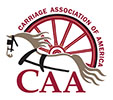The name “Runabout” was first applied to a type of low-hung buggy patented by the New York carriage maker Rufus M. Stivers. He believed in the Tilton Patent gear, which aimed at producing a buggy with a square body, with extra length and hung low, without reducing the height of the wheels or lengthening the gear. Many carriage experts thought that the light cranked axles were not practical but Mr. Stivers proved otherwise. He marketed the Stivers-Tilton Runabout as a first-class vehicle and it quickly became one of the most popular vehicles on the market.

Lamps:
Small lamps may be carried on a Runabout, mounted on a spindle holder about opposite the middle of the seat. They should be considered optional for the show ring.
The Horse:
The prize list for the National Horse Show at Madison Square Garden (NY) in 1921 gives this description for the runabout Appointment Class: “Runabout Horses, Mares or Geldings, not under 15 hands and not exceeding 15.2 hands. Horses to count 50%; runabout and appointments, 50%. Horses should have conformation, style, all-around action, pace and good manners. Horses must stand without being held.”
The Appointments:
Appointments would typically be found under the seat in a basket or other carrier. Prudent items would be a raincoat, waterproof apron, a cooler for your horse, a halter and lead rope, a wrench to fit your wheel, a hoof pick, pliers, leather punch and a small spool of wire. *If competing, check the rules for the show for appointment requirements.
Attire:
The runabout is not a formal carriage. Drivers and their passengers would be dressed in everyday attire. On all occasions, an apron or lap robe is required to protect clothes from becoming soiled. Brown gloves are word by the driver (so that the brown dye from the reins would not ruin the gloves). A whip with a thong long enough to reach the front of the saddle should also be carried. The whip acts as the drivers ‘legs’ in guiding the horse.
In the show ring a lady may wear a long-sleeved blouse with or without a jacket. A felt hat with narrow brim is most suitable. Gentlemen would wear a sport coat or blazer with a shirt and tie.
Patent Example:


A Few ‘False’ Runabouts
The name ‘Runabout’ was adopted by other makers for a four-wheeled, square-box buggy made with end-springs and no top. Soon manufacturers began producing “runabouts” without conflicting with the Stivers-Tilton patent. The most common similarity – the wheels. All of these vehicles were marketed by their manufacturers as runabouts despite lacking the gear that makes a runabout unique.



Excerpts from the January 1902 issue of The Hub and The CAA Guide to Carriage Turnout and Appointments
